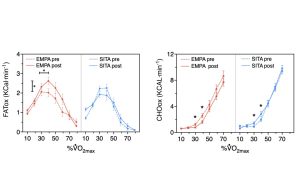Background: SGLT2 inhibitors (SGLT2i) provide cardiac and metabolic benefits as they may affect cardiac and skeletal muscle metabolism. However, their effect on macronutrient oxidation during exercise are unknown. Methods: In the randomized EMPA HEART trial (EUDRACT 2016-002225-10), we applied indirect calorimetry to breath-by-breath gas exchange analysis provided by cardiopulmonary exercise tests (CPET) to estimate lipid (FATox) and carbohydrate oxidation rates (CHOox) during progressive exercise before and after 6 months of empagliflozin vs sitagliptin in patients with T2D and normal cardiac function. We defined maximal fat oxidation rate (MFO) as the highest value of FATox, and maximal fat oxidation zone (FATmax) as the work rate at which MFO is reached. Results: Forty-one patients completed the study (21 empagliflozin vs 20 sitagliptin), achieving similar improvements in glycemic control (HbA1c -4.19 vs -4.75 mmol/mol, p=0.81). While we observed no difference in respiratory exchange rate (RER) neither at rest nor peak exercise, patients receiving empagliflozin showed an improvement in MFO (+0.299 [0.636/-0.039] vs -0.274 [0.200/-0.075] Kcal•min-1, p=0.045) and reached later FATmax (+4.91 [8.12/1.70] vs -0.15 [3.80/-4.11]%VO2max, p=0.043). Consequently, the treatment with empagliflozin was associated with a delayed CHOox in comparison to sitagliptin (p<0.05) (Fig.). The increase in both MFO and FATmax was directly correlated to the amelioration in whole-body oxygen uptake (R2=0.15, p=0.013 and R2=0.29, p=0.0003, respectively). Conclusion: When compared to sitagliptin, chronic therapy with empagliflozin produces a metabolic switch in favor of lipid oxidation during exercise. The increased FATox is directly associated to an amelioration in cardiopulmonary performance, possibly postponing CHOox to support higher exercise intensities.


